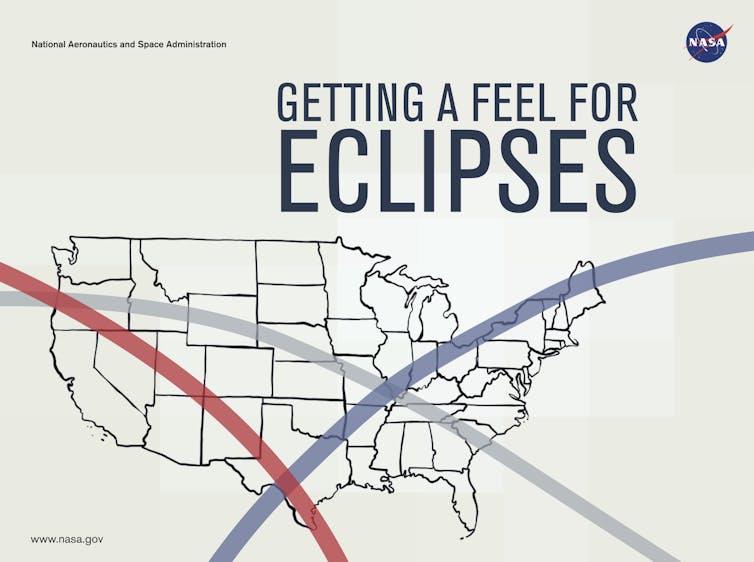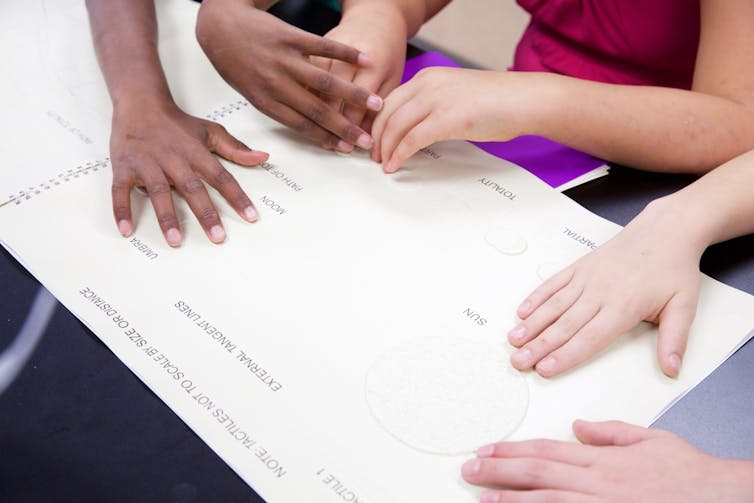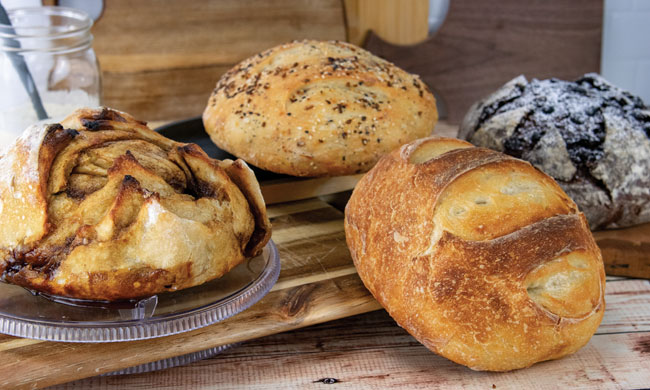Pages
- Home
- North Alabama
- Central Alabama
- South Alabama
- East Alabama
- West Alabama
- FEATURE BUSINESS
- Business Directory
- The Cumberland Mall
- Career
- COOL STUFF
- Culture & Arts
- DEALS!
- Economy
- Education
- Environment
- Food
- Health
- Our Farmers
- Politics
- Real Estate
- Science
- Tech
- Travel
- Democratic Party
- Local Democratic Party
- Republican Party
- Local Republican Party
Monday 25 2024
An eclipse for everyone – how visually impaired students can ‘get a feel for’ eclipses

Many people in the U.S. will have an opportunity to witness nearly four minutes of a total solar eclipse on Monday, April 8, 2024, as it moves from southern Texas to Maine. But in the U.S., over 7 million people are blind or visually impaired and may not be able to experience an eclipse the traditional way.
Of course they, like those with sight, will feel colder as the Sun’s light is shaded, and will hear the songs and sounds of birds and insects change as the light dims and brightens. But much of an eclipse is visual.
We are a planetary scientist and an astronomer who, with funding and support from NASA’s Solar System Exploration Research Virtual Institute, have created and published a set of tactile graphics, or graphics with raised and textured elements, on the 2024 total solar eclipse.
The guide, called “Getting a Feel for Eclipses,” illustrates the paths of the 2017 total, 2023 annular and 2024 total solar eclipses. In a total eclipse, the Moon fully blocks the Sun from Earth view, while during an annular eclipse, a narrow ring of sunlight can be seen encircling the Moon.
The tactile graphics and associated online content detail the specific alignment of the Earth, Moon and Sun under which eclipses occur.
To date, we have distributed almost 11,000 copies of this book to schools for the blind, state and local libraries, the Library of Congress and more.
Why publish a tactile book on eclipses?
NASA has lots of explanatory material that helps people visualize and understand rare phenomena like eclipses. But for people with visual impairments, maps and images don’t help. For tactile readers, their sense of touch is their vision. That’s where this guide and our other tactile books come in.
Over 65,000 students in the U.S. are blind or visually impaired. After working with several of our students who are totally blind, we wanted to find out how to make events like eclipses as powerful for these students as they are for us. We also wanted to help our students visualize and understand the concept of an eclipse.
These aims resulted in the three tactile graphics, which are physical sheets with textures and raised surfaces that can be interpreted through touch, as well as online content.
The first tactile graphic models the alignment of the Earth, Moon and Sun. The second illustrates the phases of an eclipse as the Moon moves in between the Earth and Sun to full totality, and then out of the way. The third includes a map of the continental U.S. that illustrates the paths of three eclipses: the Aug. 21, 2017, total eclipse, the Oct. 14, 2023, annular eclipse and the Apr. 8, 2024, total eclipse. We used different textures to illustrate these concepts.
Each book includes a QR code on the front cover, outlined by a raised square boundary. The code links to an online guide that leads the user through the content behind the graphics while also providing background information. With the online content, users may opt to print the information in large font or have it read to them by a device.
Although initially created to assist visually impaired audiences, these books are still helpful resources for those with sight. Some students can see but might learn better when able to explore the tactile parts of the guide while listening to the audio. Often it’s helpful for students to get the same information presented in different styles, with options to read or have the content information read to them.
How are the books made?
We hand-make each book starting by identifying which science concepts the user will likely want to know, and which illustrations can support those concepts.
Once identified, the next step is to create a tactile master, or model, which has one or more raised textures that help to define the science concepts. We pick a set of unique textures to use on the master to signify different items, so the Sun feels different than the Earth. This way, the textures of the graphics become part of the story being shared.
For example, in a model of the Sun’s surface, we use Spanish moss to create the dynamic texture of the Sun. In past projects, we’ve used textures like doll hair, sand and differently textured cardboard to illustrate planet features, instruments on spacecraft, fine surface features and more. Then, we add Braille labels for figure titles, key features and specific notes.
Once we’ve finished making the masters and laying out each page, a small family print shop – McCarty Printing in Erie, Pennsylvania – prints the page titles and key feature labels on Brailon, a type of plastic paper.
Once printed, we place the masters and the Brailon sheets on a thermoform Machine, which heats up the sheets and creates a vacuum that forms the final tactile graphics. Then, we return the pages to McCarty Printing for binding.
Viewing and experiencing the eclipse
Like fully sighted people, people with partial vision should avoid looking directly at the Sun. Instead, everyone should use eclipse glasses. If you don’t have eclipse glasses, you can use an indirect viewing method such as a colander or pinhole projector.
As the eclipse approaches totality, take time to enjoy your surroundings, feel the changes in temperature and light, and note how the animals around you react to the remarkable event using another of your senses – sound.
Cassandra Runyon, Professor of Geology & Environmental Geosciences, College of Charleston and David Hurd, Professor of Geosciences, Pennsylvania Western University
This article is republished from The Conversation under a Creative Commons license.
Sunday 24 2024
Why probation and parole don’t work as advertised
The current system of supervised release in lieu of imprisonment may do more harm than good, some experts say. How can society do a better job of rehabilitating law-breakers while keeping them from re-offending?
By Lola Butcher
Marcella Soto had four children by the time she was 22 and was on and off welfare during the years they were growing up. By 2018, she was working a government job in California when she was charged with six counts of welfare fraud. Unable to prove that she had not misreported her income many years earlier, she pleaded guilty to a single felony count.
Soto was sentenced to the maximum probation term — five years — and was required to check in with a supervisor every month. Because of the conviction, she lost her job; because of the conditions of her probation, she was unable to travel to Texas to attend the birth of her first grandchild.
Being sentenced to probation put Soto in the largest group of people in America’s criminal justice system. About 1.9 million US residents are behind bars, and 3.7 million are being monitored while they are on probation in lieu of incarceration or on parole after being let out of lockup.
Probation and parole — collectively known as community supervision — were originally conceived as alternatives to incarceration, allowing convicted criminals to be rehabilitated under supervision. But criminal justice leaders say the practices have strayed from that original mission and become so ineffective that, ironically, they contribute to America’s overcrowded prisons. These critics call for an overhaul of community supervision, including shorter terms and more support for rehabilitation. In some states, new laws are making headway.
“Nearly half of the people going into jails and prisons are coming in from a failed and broken probation and parole system,” says Robert Rooks, chief executive officer of Reform Alliance, a nonprofit advocacy group. “So if you want to address mass incarceration in this country, you have to address the phase of probation and parole.”
Changing goals
Parole and probation were originally intended as opportunities to rehabilitate offenders through support, such as help finding jobs or housing. This focus on rehabilitation began to recede in the 1970s when a tough-on-crime public sentiment emerged. Parole and probation morphed instead into systems of surveillance — intense scrutiny over long periods of time — supposedly in support of public safety.
With this shift, critics say, community supervision became a form of “net-widening,” keeping people in the criminal justice system rather than easing them back into society. “In many people’s minds, this is a good thing you get instead of going to prison,” says Vincent Schiraldi, a former commissioner of the New York City Department of Probation. “But this is a bad thing. It’s got a lot of bad outcomes for a lot of people.”
For instance, probationers must comply with a growing, often complex list of conditions — which typically number 18 to 20 — that can be difficult to meet, Schiraldi says. Avoiding contact with anyone who has a criminal conviction is hard if an offender’s family or support network includes convicts; returning home by curfew can interfere with keeping a job. In Pennsylvania, where a released prisoner could be on parole for the rest of their life, probationers are prohibited from leaving the state, which means an Uber driver on probation in Philadelphia cannot drive into the suburbs that spill into Delaware.
“That right there shows you that our current policies are arbitrary, unnecessary and hinder people’s ability to do the things they need to do to become stable, get back to work and provide for their families,” Rooks says. “And that’s the opposite of what probation and parole should be doing.”
Indeed, a 1993 survey of people imprisoned in Texas found that 66 percent said they would choose incarceration over a 10-year probation sentence. When Schiraldi was New York City’s probation commissioner in 2010, he saw a woman give up her probation, choosing instead to go to Rikers Island jail, because she was unable to find childcare that she needed for her probation check-ins, where children were not allowed.
All these problems might be acceptable if probation and parole were meeting the goal of reducing incarceration without leading to more crime. Schiraldi and two colleagues examined that proposition in the 2023 Annual Review of Criminology — and concluded that they are not.
Community supervision clearly fails at reducing incarceration. The more people living under probation and parole in one year, the higher the incarceration rate the following year, according to work by Schiraldi and his coauthors. That reflects, in part, the fact that failing to comply with terms of supervision can mean a ticket to jail. In 2017, revocation of parole or probation accounted for 45 percent of prison admissions, and in 20 states, more than half of those revocations were not for new crimes, but for violating the terms of supervision.
The evidence on public safety is more equivocal. If releasing people on parole and probation poses a risk of further crime, then the more people released on supervision in a given year, the higher the crime rate would be in the following year. But that isn’t the case. Overall, a state’s probation, parole and total supervision rate in one year does not predict the state’s rate of index crime — a term that includes violent crime plus several kinds of property crimes — in the following year.
For parole alone, however, the researchers found that the more parolees in a given year, the more violent crime the next year. That implies that parole could be risky.
But looking at the issue in a different way, Urban Institute researchers showed no clear risk, as well as no benefits, from parole. The team reviewed long-term Bureau of Justice Statistics data on 38,624 prisoners from 14 states released from prison in 1994 and found that parole supervision does not substantially affect recidivism or public safety. People simply released from prison without supervision were no more likely to be rearrested than those who were required to complete a term of parole after their sentence, they found — though people paroled before the end of their prison sentences did have lower rearrest rates.
Other evidence also suggests that recidivism may arise early, so long supervision terms may not be helpful in reducing crime. For example, among felony probationers in Oregon who were rearrested within three years of their probation, 69 percent were arrested in the first year, according to data from the Oregon Criminal Justice Commission. That suggests that the early months of probation and parole may be a critical period for helping offenders change their behavior and connecting them with community services.
In addition, making community supervision less punitive has been shown to work. One in-depth study of 283 offenders in an intensive supervision program in Wyoming compared the effect of rewards, such as praise or removal of electronic monitoring, to punishments, such as reprimands or tightened curfew. The offenders were most likely to complete their supervision successfully if they received at least four times as many rewards as sanctions.
Several studies show that employment for people under supervision helps to reduce recidivism. A transitional job program in New York City for people leaving prison led to a 9 percentage-point reduction in any type of recidivism (arrest, conviction or jail) over the three-year follow-up period compared to results with parolees not in the program. That suggests that supporting employment — rather than making it difficult by travel restrictions — is a good idea.
Evidence like this led Schiraldi and Barbara Broderick, former chief probation officer for Maricopa County in Arizona, to launch Exit, a group made up of current and former community supervision leaders, victims, prosecutors and others who want to see probation and parole downsized and returned to their original purpose of rehabilitation.
Among other aims, they want people on probation to be able to earn time off supervision if they maintain good behavior and achieve milestones like graduating from high school or keeping a job. They want the money saved from reduced supervision to be invested in community-based services that support people on probation or parole. They want incarceration for technical violations to be eliminated in favor of more and better supportive services that help people on parole and probation reintegrate into their communities.
A better way
Some of the greatest progress has been in California, where a series of reform laws since 2007 has transformed the incarceration and community supervision landscape, Rooks says. The reforms reduced prison sentences and supervision periods for many offenses and encouraged the use of evidence-based supervision strategies such as needs assessments, tailoring the intensity of supervision to a probationer’s risk of recidivism, and increased referrals to counseling, substance abuse treatment and employment services.
“In many people’s minds, [probation] is a good thing you get instead of going to prison. But this is a bad thing.”
— VINCENT SCHIRALDI
Because of these and other reforms, the number of Californians under community supervision fell from 477,733 in 2006 to 306,500 in 2020, a decrease of 42 percent. Meanwhile, reported crime declined by 7.4 percent during those years — and a study found the reforms had no measurable effect on violent crime, suggesting that less-punitive treatment did not increase crime.
Another California reform, passed in 2020, limits most probation sentences for misdemeanors to one year and most probation sentences for felonies to two. The change is projected to reduce the number of people on probation by a third, avert more than 48,000 prison stays because of technical violations and save the state $2.1 billion over five years, according to calculations by Recidiviz, a nonprofit organization that compiles and analyzes data to support criminal justice reform.
The saved money could be used to address the root causes of criminal behavior. For example, in early 2021 the El Dorado County Probation Department opened a house where probationers experiencing or at risk of homelessness can live and receive support services. “It allows you to free up the resources to give people the help that they need, which is what probation really should be about,” Rooks says.
When Soto learned about California’s new probation term limits in 2021, her probation officer did not support reducing her probation sentence, so Soto went to court. “The judge right away said, ‘You know what? I got her report. She’s never been in trouble and she’s working,’” she recalls. “And they let me off three years early.”
Now living in Oklahoma, where she works as a warehouse manager and lives with her daughter and the grandson whose birth she missed, Soto remembers that day. “I could travel and be free, and I didn’t have to worry about the visitation from the officer,” she said. “I was able to get my life back.”
The Power of Pets

Love. Community. Belonging. Pets offer people the chance to explore friendships and connections they didn’t always think were possible.
Pets provide companionship and help bring people together. In fact, according to Mars’ “Pets Connect Us” report 73% of pet parents have made connections despite generational, cultural or ethnic differences because of their four-legged pals.
Learn more about the report, which leveraged consumer insights to shed light on the future of pet parenthood in the U.S. and Canada, at BetterCitiesForPets.com/2023report.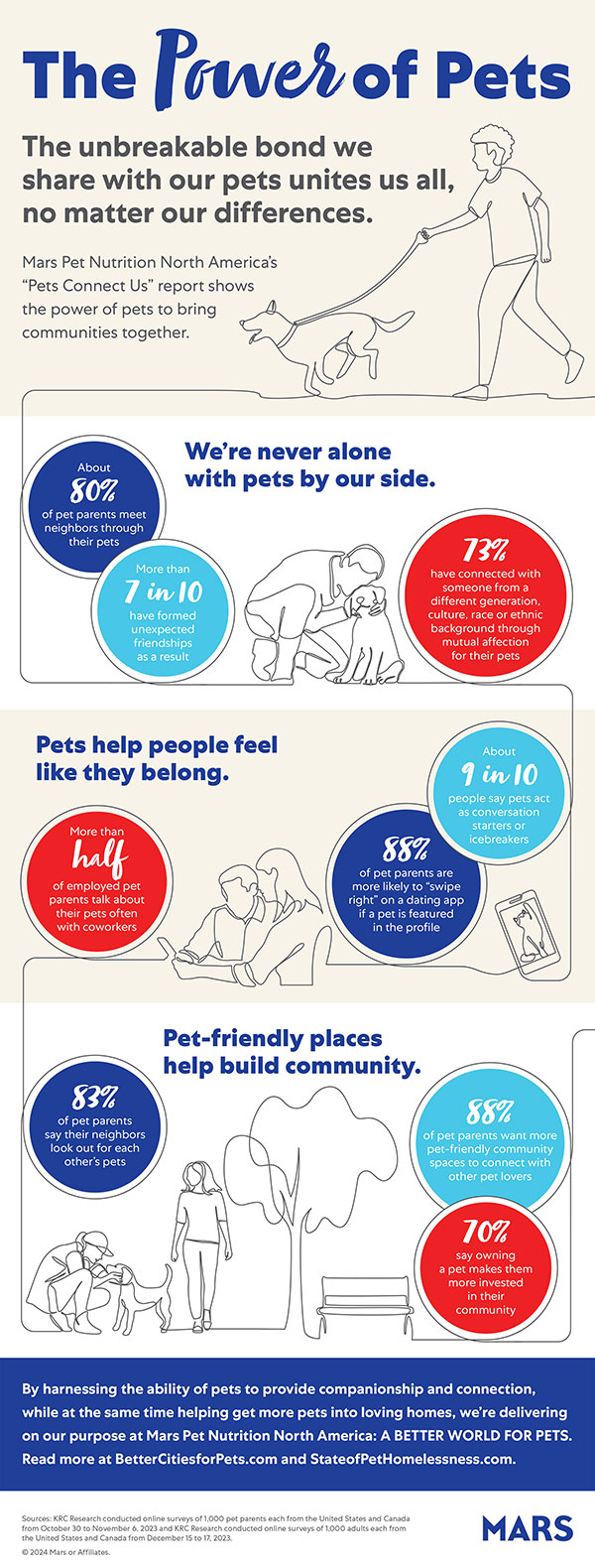
Mars Petcare
Caramel-Flavored Breakfast Fit for a Crowd
Cooking for a small crowd can be daunting. With this recipe for Caramel French Toast, you can prepare it the night before, bake in the morning and satisfy your guests without going overboard in the kitchen.
Find more breakfast and brunch recipes at Culinary.net.
Watch video to see how to make this recipe!

Caramel French Toast
- 6 slices white bread, halved
- 1/4 cup butter, cubed
- 1/2 cup brown sugar
- 1 tablespoon corn syrup
- 3 eggs
- 3/4 cup half-and-half
- 1/2 teaspoon vanilla extract
- 1/2 teaspoon cinnamon
- 1/4 teaspoon salt
- powdered sugar (optional)
- Cut bread slices in half.
- In saucepan, melt butter. Add brown sugar and corn syrup. Bring to boil, stirring frequently.
- Pour into 8-inch square baking dish. Arrange bread slices over caramel mixture.
- In small bowl, whisk eggs, half-and-half, vanilla extract, cinnamon and salt. Pour over bread slices. Cover with aluminum foil and refrigerate overnight.
- Heat oven to 350 F.
- Remove from refrigerator 30 minutes before baking and remove aluminum foil.
- Bake 25-35 minutes, or until toothpick inserted into center comes out clean.
- Sprinkle with powdered sugar, if desired; serve.
Culinary.net
Saturday 23 2024
A Straightforward Weekend Breakfast
There are no alarms set and you are cuddled up in bed after a good night’s sleep. It’s late morning and there is nowhere to go, no rushing around to do. No school bus, no work to be done, just relaxing at home with loved ones. However, breakfast is calling your name.
Your stomach rumbles as your stumble toward the kitchen. You need something quick and effortless. The kids will be up soon and you know food will be on their minds.
When you’re in a pinch, there is nearly nothing better to make than something sweet and filling for a weekend family breakfast.
Try these simple and delicious Caramel Sticky Rolls for an easy breakfast for all. The rolls are fluffy, a little crunchy and drizzled with caramel topping.
Start by sprinkling some flour on the countertop. Roll out one sheet of puff pastry. Drizzle and spread caramel sauce on the puff pastry.
Sprinkle 1/2 cup of chopped walnuts on top then roll up the puff pastry and cut it into about nine pieces to place inside a muffin tin.
Bake for 22 minutes and cool. If you like your rolls super sweet, drizzle with some extra caramel sauce.
The result is a pan full of warm, gooey and delightful rolls that are perfect for a large family or to save leftovers to enjoy throughout the week.
Next time you slept in a little too late or your family wants something more than the daily norm for breakfast, try this scrumptious and tasty recipe.
Your family will love it and don’t be surprised if you get a request or two for this breakfast again.
Find more quick weekend recipes at Culinary.net.

Caramel Sticky Rolls
Servings: 9
- Nonstick cooking spray
- flour, for rolling pastry
- 1 frozen puff pastry, thawed
- caramel sauce, divided
- 1/2 cup walnuts, chopped
- powdered sugar
- Heat oven to 400 F.
- Spray muffin tin with nonstick cooking spray.
- Sprinkle flour on work surface. Flatten pastry sheet and roll into rectangle.
- Drizzle caramel sauce over pastry and spread within 1/2 inch of edges.
- Sprinkle chopped walnuts over caramel sauce.
- Starting on short end, evenly roll pastry with filling to other end.
- Cut pastry into nine pieces. Place pastries cut side up into muffin cups.
- Bake 22 minutes, or until golden brown. Immediately remove from pan to wire rack. Let cool 10 minutes. Drizzle with additional caramel sauce and dust with powdered sugar.
Culinary.net
Nuclear’s role in a net-zero world
Is nuclear power a necessary part of the energy transition away from fossil fuels? As the debate rages on, new technologies and smaller reactors may be shifting the balance.
By Nicola Jones
In an online video from Ultra Safe Nuclear Corporation, a cartoon simulation shows a tsunami wiping out one of their future nuclear power stations and cutting off power. What happens next? Not much: The reactor quietly shuts itself down. “It cools off just by sitting there, no moving parts or fluids, no operator actions,” says the reassuring video. “We’ve designed a reactor that is inherently safe no matter the events.”
The Seattle-based Ultra Safe and dozens of other companies like it are at the forefront of a global nuclear energy revival. As the world urgently needs to wean itself off fossil fuels, reduce greenhouse gas emissions and get the planet’s temperature under control, policymakers, companies and researchers are reexamining nuclear energy as a green alternative that can help bolster the power produced by renewables like wind and solar. Today the industry is emerging from a period of stagnation, with a promise to double or triple its capacity by 2050.
That revival is undergirded by two hot technology trends. Companies like Ultra Safe are aiming to build small modular reactors (SMRs) designed to be just a fraction of the size of former plants, to reduce both building costs and the scope of possible disasters. And many are aiming to utilize new technologies designed to make meltdown accidents impossible and to create less long-lived waste.
This video (from Ultra Safe Nuclear Corporation, a nuclear power company) shows the safety features built into a design for a small modular reactor.
CREDIT: ULTRA SAFE NUCLEAR CORPORATION
But the surge in interest is not without controversy. As with everything in the nuclear landscape, debate rages about whether society actually needs nuclear to tackle climate change, and whether the new systems are as shiny as they seem — with reasonable arguments for and against every promise and risk. Some say the new technologies could offer a fantastic solution to our energy woes; others say nuclear is beset with so many environmental, social and economic problems that it is best abandoned in favor of other ways to meet the globe’s energy demands.
The next few years will decide what course nuclear power takes in the world’s energy future. “This is a moment of truth,” says Francesca Giovannini, a nuclear policy expert at the Harvard Kennedy School. Over the next few decades, nuclear power is “either going to make it, or that industry is fundamentally done for. ... It’s 50/50 how this goes.”
Ups and downs in nuclear power output
Nuclear power poses some obvious risks — meltdown accidents, nuclear fuel being diverted to weapons programs, environmental issues posed by mining for uranium, the problems of storing nuclear waste. Against a backdrop of such concerns, alongside shifting economics of energy production, nuclear power production started to level off in the early 2000s and even dipped briefly after the Fukushima power plant accident of 2011. Some nations, most notably Germany, decided to shutter their nuclear programs entirely. But global nuclear power production is now starting to inch upward again.
Today, nuclear plants produce about 10 percent of global electricity, making nuclear the second largest source of non-fossil-fuel energy after hydropower. There are about 440 nuclear power plants in operation globally; another 60 or so are now being built, and around 100 are on order or planned.
Most Intergovernmental Panel on Climate Change scenarios for keeping the world below 1.5 degrees Celsius of warming include some kind of increase in nuclear power capacity. In the International Energy Agency’s (IEA) pathway to net zero, global nuclear power production doubles over 2022 levels by 2050. A key reason for this is that nuclear is seen as a good way to provide consistent baseload power to prop up more variable renewable sources of energy like wind or solar. Without nuclear, advocates say, we would need to build far more wind and solar power plants to ensure reliable supplies, doubling or tripling costs over power networks that include nuclear.
Nuclear has plenty of advantages: It produces no carbon emissions (and, counterintuitively, releases less radioactive uranium and other elements into the environment than burning coal does). It takes up a lot less land than renewables, a not insignificant consideration. If the goal is to decarbonize quickly and with as little social pain as possible, “nuclear is essential,” says Kai Vetter, a nuclear physicist at the University of California, Berkeley.
At the UN’s Convention on Climate Change meeting in Dubai in December 2023, more than 20 nations signed a declaration to triple nuclear capacity by 2050. And cash is flowing into this effort. In 2020, the US Department of Energy (DOE) notably gave $160 million for two demonstration plants to get up and running by 2027. And in 2022, the European Union declared that some nuclear projects could call themselves “green” in the same way as renewables, opening the door to environmental financing mechanisms.
But as with almost every issue relating to nuclear power, the arguments in favor of nuclear have their detractors. Public policy expert M.V. Ramana at the University of British Columbia is one of many, for example, who say that baseload power is an outdated concept. A smart, diverse and flexible electric grid, they argue, can assure a reliable power supply by shunting power among sources and storage facilities.
And with the cost of renewables falling fast, today’s economic estimates about the relative costs of power sources may not mean much in the future.
Then there’s the question of safety. The grand total of lives lost from all nuclear power generation to date, while hard to quantify, is certainly far lower than the number of people killed by air pollution related to the burning of fossil fuels; a recent paper by NASA scientists concluded that nuclear power saved roughly 1.8 million lives from 1971 to 2009 thanks to avoided air pollution. By some accounts nuclear power has also proved less deadly than wind power, which has been linked to drownings at offshore wind farm sites and helicopter collisions with turbines.
But fatality is arguably a blunt way to measure the impacts of the nuclear industry, which also include the risk of accidents contaminating large tracts of land, plus numerous other effects related to such things as mining and waste storage. Ramana has documented how the burden of these last issues falls disproportionately on Indigenous and disempowered communities, working against the goals of social justice. Nuclear power, he writes, “does not fit with any idea of a responsible and cleaner energy system.”
Small and shiny: New nuclear technologies
If we are to pursue nuclear power at the scale called for by the IEA, it will take a herculean effort. The IEA’s pathway requires the world to ramp up from building five big nuclear plants per year to 20 per year over the next decade. Big plants typically cost billions of dollars and come with big financial risks. Westinghouse Electric Company, for example, recently filed for bankruptcy in the face of billions of dollars of cost overruns during the construction of four nuclear plants in the United States.
One plan for reducing those epic and prohibitive costs is to build small modular reactors, ranging from reactors that can be shipped on a truck and produce a couple of hundred megawatts, to tiny single-megawatt sizes that are more akin to hefty diesel generators. The modules could be pre-built in a factory and shipped to a site for installation. All this should make these reactors less frightening prospects for investors (though the end price per unit of electricity might wind up higher than that from a larger nuclear power plant).
A handful of SMRs are already in operation in Russia, China and India. Dozens more are in development. Canada has a national SMR action plan, and as of 2021 there were 10 SMR proposals under review (including one from Ultra Safe).
But so far, the promise of enticingly low costs for SMR builds hasn’t materialized, says Granger Morgan, a physicist and codirector of the Center for Climate and Energy Decision Making at Carnegie Mellon. Morgan has crunched the numbers for nuclear in the US and was disappointed. “I thought SMRs were going to hold much more promise, but we can’t make the numbers wash,” he says.
That message was hammered home in November 2023 when the company NuScale scrapped its high-profile advanced plans to build an underground SMR in Idaho in the face of cost hikes. “Would it be nice to have nuclear? Yes absolutely,” says Morgan. “Will it be affordable? That’s very much an open question.”
Others argue that small isn’t always beautiful. While smaller plants present a smaller risk from smaller potential accidents, this strategy also means more plants overall, which means more facilities to protect against theft and terrorism. “You have way more fissile material dispersed; you will have to secure way more infrastructure,” says Giovannini. “I mean, that becomes a mess.”
Next generation nuclear
While some are focusing on making nuclear plants smaller, there’s a parallel movement to make them safer and more efficient. The next generation of reactor designs — Generation IV, in the industry’s lingo — includes a suite of six major reactor families, all very different from today’s standard, each with many possible variants under development. Much of the attention (particularly in the US) has been focused on three of these: high-temperature gas-cooled, molten salt and sodium-cooled.
The ideas behind these technologies, and even some early-stage power plants, have been around for decades. But the new variants of these old ideas combine novel fuels and designs, promising to be safer, more efficient and environmentally friendly. “They’re doing all kinds of whizz-bang, high-tech stuff,” says Morgan, who has no doubt that newer reactors can be made safer than old ones.
Most existing reactors are water-cooled uranium systems, which were chosen as the dominant technology largely as a quirk of history. Like all reactor types, they have their pros and cons. They need high pressures to stop their coolant waters from boiling off at typical operating temperatures around 300 degrees Celsius. And they are designed to work with relatively slow-moving neutrons — the subatomic particles that collide with nuclear fuel to initiate nuclear fission. Slow-moving neutrons are more likely to interact with fuel particles, but systems that use them are also limited in the kinds of fuels they can use. Catastrophe can strike if the fission reaction runs amok or the reactor gets too hot and the core “melts down,” as happened at Three Mile Island, Chernobyl and Fukushima, spewing radiation into the environment.
The latest models of water-cooled reactors (sometimes called Gen III Plus, including many SMRs) use new design tricks to reduce the number of safety systems that require human intervention, aiming to stop accidents in their tracks automatically. Gen IV reactors, though, use entirely different coolant materials, are usually designed to operate at higher, more efficient temperatures, and often use faster-speed neutrons that can convert the most prevalent natural isotopes of uranium into usable fuel, or even feed on nuclear waste.
High-temperature gas-cooled reactors, for example, run at temperatures up to 950°C, making them 20 to 33 percent more thermally efficient than water-cooled reactors. Since the core materials used in these reactors are typically stable up to 1,600°C, which is hotter than lava, there’s a large margin of safety. The reactor in Ultra Safe’s video is an SMR that falls into this category; its small size helps, too, with passive cooling. Ultra Safe also makes their own fuel pellets, encased in a bespoke material that they say retains radioactive materials even in extreme conditions. They’re hoping to build their first commercial micro-reactor in Canada.
In molten salt reactors, both fuel and coolant are already liquid. So meltdowns, in the traditional sense, are impossible. And liquid-sodium-cooled reactors have a built-in safety feature: If they heat up, the liquid sodium expands and allows more neutrons to escape through the gaps between atoms, so the reaction (which is driven by neutrons) naturally winds down. The US Department of Energy has funded the US company TerraPower (which has Bill Gates as a major investor) to build a demonstration plant of its sodium-cooled Natrium reactor in Wyoming by 2030.
Nuclear waste not, want not
Waste is one area where the new designs really see some significant improvements, says Giovannini. “None of the reactors have entirely solved the problem of nuclear waste, but they do provide some significant solutions in terms of quantity,” she says. The spent fuel from traditional light water reactors needs to be buried in special repositories for hundreds of thousands of years, because of the production of long-lived radioactive byproducts. Some Gen IV reactors, on the other hand, can transform spent fuel into more fissile isotopes and use it for further fission reactions. This can improve efficiency and produce waste that need only be stored for hundreds of years.
Not everyone, though, thinks all these systems are as shiny as they seem. In 2021, the Union of Concerned Scientists published a report entitled “‘Advanced’ Isn’t Always Better,” in which they highlighted issues with safety, sustainability and nuclear proliferation. They concluded that nearly all the Gen IV reactor types “fail to provide significant enough improvements over [light water reactors] to justify their considerable risks.”
The report was criticized by some for being ideologically antinuclear, says Giovannini. But, she says, “it was very fair” to point out that new tech comes with new worries. Liquid salt, the report pointed out, is corrosive; liquid sodium metal can burst into flame when in contact with water or air. High-temperature gas-cooled reactors, the report concluded, while tolerant of high temperatures, are “far from meltdown-proof, as some claim.”
Hot idea
Many of these Gen IV systems offer another key benefit: Their higher temperatures can provide not just electricity but also useful heat. This could be used in many industrial processes, such as the production of steel, cement and fertilizer, which currently burn a lot of fossil fuels in their furnaces.
“That heat is pretty much for free,” says Vetter, who sees a particular utility for nuclear heat in desalination, getting clean drinking water out of saltwater as is done at the Diablo Canyon nuclear power plant in California. Indeed, X-energy, a leading US Gen IV nuclear company funded by the DOE, has partnered with Dow chemical company to build its first high-temperature gas-cooled reactor at a Dow chemical production site by 2030. Morgan, though, thinks that most industries will balk at the set-up costs.
Even if Gen IV reactors turn out to be technically superior, though, it may be decades before they can be thoroughly tested, passed by regulators and built at commercial scale. With little time to spare in the fight against climate change, the world might be better off simply ramping up old reactor designs that are already proven, says Esam Hussein, a retired nuclear engineer from the University of Regina, Canada. “We have the operating experience, we have the regulatory framework,” he says. “If the goal is to fight climate change, why don’t you go with the devil you know?”
In response to why we need a devil at all, many are quick to point out that no energy solution is problem-free, including renewables. Giovannini says she agrees with the nuclear industry’s criticism that we have “jumped on renewables in a very uncritical way.” Wind and solar require electronics and battery banks to store their energy; these in turn need elements like lithium and cobalt that can come with environmental and social justice issues from mining. “Nothing is 100 percent safe,” says Vetter.
It is hard for many to swallow data, assurances and statistics about nuclear, given its history and the huge amounts of money at stake. “I think the nuclear industry is selling a bunch of bullshit most of the time,” says Giovannini, who has been critical of how the industry deals with public concerns. But her own main worry about nuclear is “they’re moving too slow.” If companies like Ultra Safe, X-Energy, TerraPower and others are going to help fight climate change with Gen IV technologies and fleets of small reactors, she and others say, they’re going to have to ramp up fast.
Editor’s note: This story was updated on March 20, 2024, to change a name: Granger Morgan was referred to as Granger instead of Morgan in one reference. It was updated on March 21, 2024, to correct the specialty of Esam Hussein. He is a retired nuclear engineer, not a retired nuclear physicist.
Knowable Magazine
Sourdough from Scratch: 4 variations of friendship breads
What better way to celebrate friendship and camaraderie than with comforting foods all can enjoy. Sourdoughs and friendship breads may go in and out of fashion, but you can make them a staple of your inner circle with recipes that are easier than they appear.
Consider this Sourdough Starter, a 7-day process that may seem lengthy at first glance but requires just a few minutes in the kitchen each day. Without breaking the bank, this made-from-scratch solution includes just two ingredients – unbleached flower and warm water – so you can whip up favorites like Plain Sourdough, Everything Loaf, Cinnamon Brown Sugar Loaf and Chocolate Loaf.
Some are tempted to give up on a weeklong recipe, but if you can keep a houseplant alive, you can finish this simple starter and reap its delicious rewards.
Find more homemade favorites at Culinary.net.Sourdough Starter
Recipe courtesy of "Cookin' Savvy"
Total time: 7 days
- Digital kitchen scale
- Unbleached all-purpose flour
- Warm water
- Glass bowl
- Silicone spoon
- Mason jar
Day 1: In glass bowl, stir 50 grams flour and 50 grams warm water. Let sit at room temperature, covered.
Day 2: Add 50 grams flour and 50 grams warm water to bowl. Stir and let sit at room temperature, covered.
Day 3: Discard half the starter. Add 100 grams flour and 100 grams warm water. Stir and let sit at room temperature, covered.
Day 4: Discard half the starter. Add 150 grams flour and 150 grams warm water. Stir and let sit at room temperature, covered.
Day 5: Discard half the starter then pour remaining starter into Mason jar. Add 150 grams flour and 150 grams warm water. Stir and let sit at room temperature, covered.
Day 6: Discard half the starter. Add 200 grams flour and 200 grams warm water. Stir and let sit at room temperature, covered.
Day 7: Place warm water in bowl and add spoonful of starter to water. If it floats, it's ready to make bread. If it sinks, repeat Day 6 instructions. If not floating by Day 10, throw out and start over.
Tips: If making bread every day, starter will need fed every day. If not making bread every day, starter can stay at room temperature and be fed every other day. If starter can't be fed, it can be safely stored in refrigerator up to 10 days, covered, without feeding.
To measure correctly, place empty bowl on scale then clear to zero before each measurement.
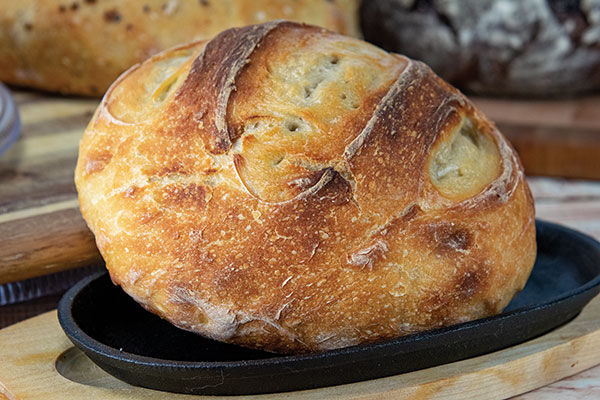
Plain Sourdough
Recipe courtesy of "Cookin' Savvy"
- Medium bowl
- Warm water
- Sourdough starter
- Salt
- Unbleached all-purpose flour
- Silicone spoon
- Sharp knife
- In medium bowl, combine 330 grams warm water, 90 grams sourdough starter and 10 grams salt. Stir well then add 525 grams flour. Using silicone spoon, mix dough to sticky ball. Let rest, covered, about 45 minutes.
- Pull dough from bottom and stretch to top of dough ball. Repeat around entirety of dough ball a few times then cover. Repeat process four times then cover and let sit at room temperature at least 6 hours but no more than 14 hours. Dough should double.
- Sprinkle flour on counter then spread dough flat on floured surface. Fold dough from sides then turn and roll into ball. Place on parchment paper and put back in bowl 1 hour.
- Heat oven to 500 F with uncovered Dutch oven inside.
- Using sharp knife, score dough then place parchment paper and dough in Dutch oven. Cover with lid and bake 20 minutes then remove lid and lower temperature to 475 F for 25 minutes. Internal temperature should reach 195-205 F. Let rest at least 1 hour before cutting and serving.

Everything Loaf
Recipe courtesy of "Cookin' Savvy"
- Medium bowl
- Warm water
- Sourdough starter
- Salt
- Unbleached all-purpose flour
- Silicone spoon
- Everything bagel seasoning
- Sharp knife
- In medium bowl, combine 330 grams warm water, 90 grams sourdough starter and 10 grams salt. Stir well then add 525 grams flour. Using silicone spoon, mix dough to sticky ball. Let rest, covered, about 45 minutes.
- Pull dough from bottom and stretch to top of dough ball. Repeat around entirety of dough ball a few times then cover. Repeat process four times then cover and let sit at room temperature at least 6 hours but no more than 14 hours. Dough should double.
- Sprinkle flour on counter then spread dough flat on floured surface. Sprinkle with everything bagel seasoning. Fold dough from sides then turn and roll into ball. Place on parchment paper and put back in bowl 1 hour.
- Heat oven to 500 F with uncovered Dutch oven inside.
- Using sharp knife, score dough then place parchment paper and dough in Dutch oven. Cover with lid and bake 20 minutes then remove lid and lower temperature to 475 F for 25 minutes. Internal temperature should reach 195-205 F. Let rest at least 1 hour before sprinkling with everything bagel seasoning, cutting and serving.
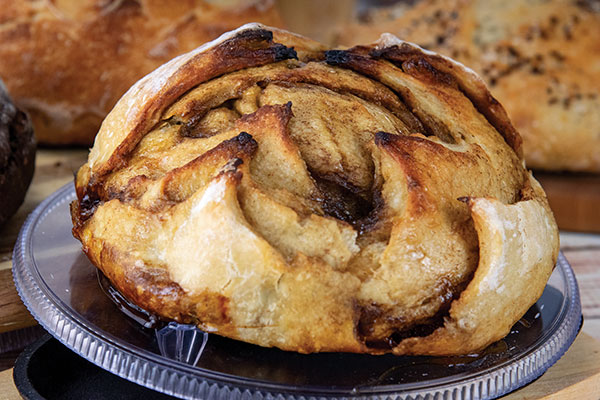
Cinnamon Brown Sugar Loaf
Recipe courtesy of "Cookin' Savvy"
- Medium bowl
- Warm water
- Sourdough starter
- Salt
- Unbleached all-purpose flour
- Silicone spoon
- Softened butter
- Brown sugar
- Cinnamon
- Sharp knife
- In medium bowl, combine 330 grams warm water, 90 grams sourdough starter and 10 grams salt. Stir well then add 525 grams flour. Using silicone spoon, mix dough to sticky ball. Let rest, covered, about 45 minutes.
- Pull dough from bottom and stretch to top of dough ball. Repeat around entirety of dough ball a few times then cover. Repeat process four times then cover and let sit at room temperature at least 6 hours but no more than 14 hours. Dough should double.
- In bowl, mix 4 tablespoons butter, 1/2 cup brown sugar and 2 tablespoons cinnamon.
- Sprinkle flour on counter then spread dough flat on floured surface. Spread cinnamon mixture on dough. Fold dough from sides, pinching to keep cinnamon inside, then turn and roll into ball. Place on parchment paper and put back in bowl 1 hour.
- Heat oven to 475 F with uncovered Dutch oven inside.
- Using sharp knife, score dough then place parchment paper and dough in Dutch oven lined with aluminum foil. Cover with lid and bake 20 minutes then remove lid and lower temperature to 450 F for 25 minutes. Internal temperature should reach 195-205 F. Let rest at least 1 hour before cutting and serving.
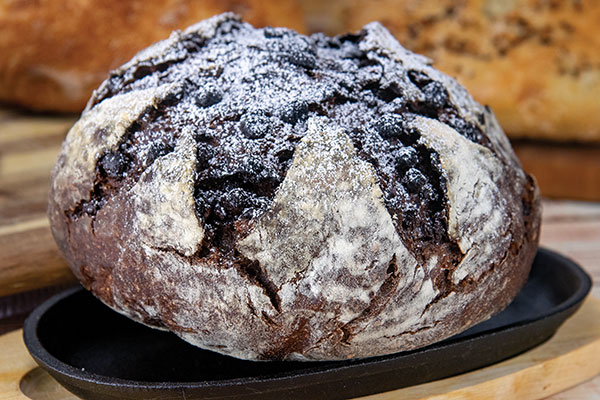
Chocolate Loaf
Recipe courtesy of "Cookin' Savvy"
- Medium bowl
- Warm water
- Sourdough starter
- Salt
- Unbleached all-purpose flour
- Cocoa powder
- Sugar
- Silicone spoon
- Milk chocolate chips
- Sharp knife
- In medium bowl, combine 350 grams warm water, 150 grams sourdough starter and 10 grams salt. Stir well then add 500 grams flour, 50 grams cocoa powder and 50 grams sugar. Using silicone spoon, mix dough to sticky ball. Let rest, covered, about 45 minutes.
- Pull dough from bottom and stretch to top of dough ball. Repeat around entirety of dough ball a few times, adding 1 1/2 cups milk chocolate chips during process, then cover. Repeat process four times then cover and let sit at room temperature at least 6 hours but no more than 14 hours. Dough should double.
- Sprinkle flour on counter then spread dough flat on floured surface. Fold dough from sides then turn and roll into ball. Place on parchment paper and put back in bowl 1 hour.
- Heat oven to 450 F with uncovered Dutch oven inside.
- Using sharp knife, score dough then place parchment paper and dough in Dutch oven. Cover with lid and bake 40 minutes. Internal temperature should reach 195-205 F. Let rest at least 1 hour before cutting and serving.
Culinary.net
How to Write Better Emails: Communicating with Clarity and Kindness
by Casey McCormick, PhD

Wherever you work in higher education, email probably takes up a huge part of your daily routine. An overflowing inbox causes anxiety, a rude email can ruin your day, and that message-you've-been meaning-to-send takes up vastly more mental space than it should.
Despite email's omnipresence in our lives, there are very few hard-and-fast rules about how to do it, and differing communication styles can lead to misunderstanding, email bloat, and hurt feelings. So, if you're looking to establish some best practices and improve your digital communication acumen, read on to learn how to write better emails.
Formatting and Basic Etiquette
The most important aspect of any email is clarity -- ensuring that the recipient knows exactly what you want to convey. In addition to clear and direct language, simple formatting choices can improve the readability and flow of your email. Use line breaks to separate the greeting, body paragraph(s), and sign-off, and bold key dates or numbers to make them stand out. Keep your email as concise as possible: short sentences, 1-3 sentences per paragraph, and an overall length of no more than 150 words.
As for which salutations to use, follow the advice of journalist Victoria Turk in her 2019 TED talk. She recommends using "Hi" rather than "Dear," unless it's a particularly formal context, like an event invitation or job application. Turk also insists that "there is a correct way to sign off an email. It is 'Best wishes.' 'Best' and 'All the best' are also acceptable." Importantly, she urges email writers never to use "thanks in advance" as a sign-off: "You can't thank someone for doing something before they've agreed to do it -- that's not how gratitude works." If you're dealing with an email chain or thread, Turk notes that it isn't necessary to repeat salutations with each new message, as that could ruin the conversational flow. But if it's a new day, feel free to say "hi" again.
The subject line is a useful tool for bringing specificity to your email communication. A detailed (but succinct) subject description signals to your recipient exactly what to expect in the message so they are prepared to extract the appropriate information. It also makes the email easy to find later if anyone needs to search their inbox for the thread. Finally, when dealing with group email communication, make sure you follow "the CC rule," as Turk calls it: "Primary recipients of an email, who are expected to respond, should go in the 'To' field. Other recipients of an email, who are not expected to respond, and who are included as a courtesy or for their information, should go in the 'CC' field." "BCC" should only be used to safeguard sensitive information in a large group or to avoid a "reply-all-pocalypse."
Tone and Style
While it can be tempting to use five-dollar words and descriptive detail to convey your knowledge and excitement about a subject, this type of writing is not conducive to a clear and concise email. Remember that the goal is to make reading your message as easy as possible for the recipient -- that means no extraneous information, no flowery language, and no jargon. As Turk argues, "good etiquette is not about the fancy flourishes, it's about respecting other people's time." One useful trick for ensuring your email flows clearly and conveys its point succinctly is to read the message aloud to yourself before sending it. Would you want to receive that email? If not, revise and try again.
Clarity and concision are the primary goals of any email, but Turk warns that it is also possible to be too concise. "There's a line where brevity crosses over into rudeness," she says. "A single word is not a sufficient message" and "no one is too busy for please and thank you." Remember that you're having a conversation with a human being -- use full sentences and a friendly tone. That's why Turk is "pro-emoji" in most email contexts: "Emoji are great at communicating sentiment; they're basically a digital stand-in for facial expression." Of course, be careful never to overuse emoji (or exclamation points!), but a few small punctuation choices or emoji gestures can make all the difference in how your messages come across to readers.
Kindness Saves the Day
Higher education can be a stressful place, and unfortunately, lots of folks are overworked and underpaid. Emailing requires serious physical and emotional labor, and a never-ending inbox -- especially if it's loaded with unnecessary or poorly written messages -- can contribute to symptoms of burnout. Make your number one goal "reducing the burden of email," as Turk puts it. Model clear, succinct communication, and keep your emails to business hours unless the matter is truly urgent. If you tend to work at off hours, use the "schedule send" function as a courtesy to your recipient.
Lastly, think about a time when you received an email that made your day better. Maybe they are few and far between, but there are no doubt moments where a kind message can change your mood and pull you out of an inbox slump. When digital communication feels natural and sincere, it becomes easier to write and takes less mental energy. With some practice and intention, you will be writing better emails and, by example, helping those in your network do the same.
This article is republished from HigherEdJobs® under a Creative Commons license.
Why isn’t dental health considered primary medical care?
Ailments of the mouth can put the body at risk for a slew of other ills. Some practitioners think dentistry should no longer be siloed.
By Lola Butcher
The patient’s teeth appeared to be well cared for, but dentist James Mancini did not like the look of his gums. By chance, Mancini knew the man’s physician, so he raised an alert about a potential problem — and a diagnosis soon emerged.
“Actually, Bob had leukemia,” says Mancini, clinical director of the Meadville Dental Center in Pennsylvania. Though he wasn’t tired or having other symptoms, “his mouth was a disaster,” Mancini says. “Once his physician saw that, they were able to get him treated right away.”
Oral health is tightly connected to whole-body health, so Mancini’s hunch is not surprising. What is unusual is that the dentist and doctor communicated.
Historically, dentistry and medicine have operated as parallel fields: Dentists take care of the mouth, physicians the rest of the body. That is starting to change as many initiatives across the United States and other countries work to integrate oral and whole-body care to more effectively tackle diabetes, cardiovascular disease, joint replacements and many other conditions. The exact relationship between health of mouth and teeth and physical ailments elsewhere in the body is not well understood — and in some cases, is contentious — but experts agree there are links that should no longer be overlooked.
In recent years, dental hygienists have started working in medical clinics; physicians and dentists have started a professional association to promote working together; and a new kind of clinic — with dentists and doctors under one roof — is emerging.
“We are at a pivotal point — I call it the convergence era — where dentistry is not going to be separated from overall health for much longer,” says Stephen E. Thorne IV, founder and CEO of Pacific Dental Services, based in Irvine, California. “Dentistry will be brought into the primary care health-care team.”
Sick mouth, sick body
The list of connections between oral health and systemic health — conditions that affect the entire body — is remarkable. For starters, three common dental issues — cavities, tooth loss and periodontal disease — are all associated with heart disease, the leading cause of death in the United States. “To me, the number one hidden risk factor for the number one killer in our country is oral health,” says Ellie Campbell, a family physician in Cumming, Georgia, and board member of the American Academy for Oral Systemic Health, founded in 2010 to increase awareness of how oral and whole-body health are related.
Periodontal disease, infection and inflammation of the gums and bone that support the teeth, is the main culprit. Nearly half of adults 30 and older have periodontal disease; by age 65, the rate climbs to about 70 percent. In the early stages, called gingivitis, gums are swollen and may bleed. Periodontitis, a more serious condition in which gums can pull away from the teeth, is the sixth most common human disease.
Periodontitis is associated with a slew of systemic ills: heart attacks, strokes, heart failure, diabetes, endocarditis, chronic kidney disease, recurrent pneumonia, chronic obstructive pulmonary disease, gastritis, rheumatoid arthritis, cancer and cognitive impairment.
Bad habits, including tobacco use, alcohol consumption and high-sugar diets, are implicated too. They raise the risk for cavities and most oral diseases, and are also linked to ills such as cancer, chronic respiratory disease and diabetes.
Such connections were apparently lost on officials at the University of Maryland in 1837, when the university rebuffed a proposal from two physicians to teach dentistry to the school’s medical students. At the time, medicine wanted nothing to do with dentistry, which was practiced by unregulated and inadequately trained itinerants, says medical and dental historian Andrew I. Spielman, a dentist and oral surgeon at the New York University College of Dentistry. “There were a lot of charlatans,” he says. “They had a very bad reputation.”
The dismissal prompted the rejected physicians, Horace Hayden and Chapin Harris, to establish the world’s first dental school, the Baltimore College of Dental Surgery. Today, dentistry is a highly regulated profession, and the United States has 73 accredited dental schools.
Despite their disparate training, both doctors and dentists are aware that mouth health is important to whole-body health, Campbell says. “Ask a family practice doctor and they will say ‘Oh yeah, if the patient has diabetes, they’re going to have bad teeth and gums, and I can never get their diabetes better until the dentist fixes their gums,’” she says. “And the dentist is going to say, ‘Well, I’ll never get their gums better until the primary care doctor gets their sugar under control.’”
Mancini, the Pennsylvania dentist, says dentists often are asked to examine a patient’s mouth before physicians will proceed with certain treatments. “Physicians know any infection in a patient who’s being treated for cancer could be very much life-threatening,” he says. “The orthopedic guys are now sending all of their patients to the dentist for the same reason.”
Hurdles to holistic care
But working together to improve a patient’s health is not as simple as it might seem. A decade ago, the federal government hired the National Network for Oral Health Access to run a pilot program merging oral and primary health-care centers. The network’s dental consultant, Irene Hilton, a dentist with the San Francisco Department of Public Health, said three barriers to integration became clear.
The fragmented way that health care and dental care are paid for is one of them. While more than 90 percent of Americans have health insurance, only 77 percent of US adults ages 19 to 64 have dental coverage, which typically is sold separately from health insurance. The nation’s largest insurer — the federal Medicare program — generally does not cover dental services, and nearly half of Americans 65 and over have no dental coverage.
That causes problems for patients who need, say, a joint replacement that would be covered by insurance but who cannot afford the dental work that is needed in advance. Surgeons won’t replace a knee until patients first get their dental work done, Mancini says, “so we’re kind of the barrier to them improving their life.”
Another barrier is that dentists and physicians are not routinely trained to work with each other, Hilton says.
Dental students study anatomy, physiology and other sciences related to the whole body, then home in on clinical care for mouth and teeth. But many physicians have almost no training in oral health. A 2009 survey found that 10 percent of medical schools that responded offered no oral health curriculum, and 69 percent offered fewer than five hours on the subject.
A third issue is what Hilton calls infrastructure. In most cases, the electronic health records used by physicians are incompatible with those used by dentists, so sharing information electronically is impossible. Likewise, dental offices are typically not embedded in medical clinics, where doctor-dentist referrals might be easier.
If oral and systemic health are to be integrated broadly, “these are the things that have to be overcome or addressed,” Hilton says.
The situation is not much different in other parts of the world. In 2021 the World Health Organization — noting that oral diseases are a global public health problem affecting nearly 3.5 billion people — recommended that dentistry focus more on prevention and be more integrated with primary care services.
Demonstrated links
In the past quarter-century, a great deal of research has demonstrated the links between oral and whole-body health. For example, when researchers followed 15,456 patients from 39 countries with stable coronary heart disease for nearly four years, they found that those who had lost the most teeth had the highest risk of having a stroke, heart attack or cardiovascular death. Similarly, a study that tracked 7,466 US adults ages 44 to 66 for an average of 14.7 years revealed that those who had severe periodontitis had a greater risk of cancer than those with no or mild periodontitis.
In 2015, the Harvard School of Dental Medicine launched an initiative to support integration of the two fields — in education, insurance and professional practice. (The initiative gets funding from dental product brands and health insurance companies, and Thorne, the Pacific Dental Services CEO, serves on its board.) “We’ve published papers identifying links between periodontal disease and diabetes, hypertension, dementia, adverse birth outcomes, low birth-weight babies, preterm birth, spontaneous abortion, kidney disease,” says Jane Barrow, the initiative’s executive director.
But correlation is not the same as cause and effect, and scientists have not nailed down the exact relationship between periodontitis, which affects more than 11 percent of the global population, and various systemic diseases.
Periodontitis is associated with bacteria in the bloodstream and systemic inflammation, which can affect organs such as the liver and bone marrow. That, in turn, can trigger or aggravate other conditions. And the periodontal bacteria — that travel via the bloodstream, inhalation or ingestion — may also cause infections or exacerbate inflammation in other parts of the body.
When the major professional societies for periodontology in the United States and Europe convened a group of global experts in 2012 to review the science, they concluded that it was “biologically plausible” that the inflammation of periodontitis ups the risk of cardiovascular disease and influences type 2 diabetes and other maladies – but “plausible” was as far as they would go.
Seven years later, the European Federation of Periodontology and the World Heart Federation again gathered experts to review new studies on the link between periodontitis and cardiovascular problems. Again, though scientists had made some headway in identifying possible biological mechanisms to explain the link, experts have since concluded that the evidence does not yet prove that periodontitis actually causes strokes, heart attacks or anything else.
Flipping the question on its head, does preventing or treating periodontal disease help to prevent heart problems? Several observational studies, in which researchers observe individuals and measure particular outcomes, but don’t intervene, suggest that oral health care, including toothbrushing and dental cleanings, make a difference. For example, a study that tracked the health habits of 11,869 adults 35 and older in Scotland found that within eight years, those who rarely brushed their teeth had more cardiovascular problems compared with those who brushed twice a day.
That still does not prove that preventing periodontitis will hold heart problems at bay: Some other habit or feature of the toothbrushing group could have been the important factor. The relationship is difficult to tease out, Barrow says, because people who are taking good care of their mouths tend to take good care of themselves in general. “Could you say that people who are taking care of their mouths are in better health overall? You would probably find that to be true,” she says. “Is it because they’re taking care of their mouth? I can’t say that.”
And nobody else should say that either, according to a 2018 editorial in the Journal of the American Dental Association. The coauthors, a group of dental and public health researchers, cautioned against overstating the oral-systemic health connection. “The main reason for maintaining good oral health is because it is important in and of itself,” they wrote.
One of the contributors, Bryan Michalowicz, a dental researcher at HealthPartners Institute in Minnesota, later led a team that reviewed the medical records and insurance claims of 9,503 patients to see if periodontitis treatment improved the health outcomes of those with coronary artery disease, cerebrovascular disease or type 2 diabetes.
Overall, cardiovascular patients who received dental treatment and follow-up maintenance saw no difference in the rate of heart attacks, strokes, bypass surgeries or angioplasty procedures compared to those who were not treated, the team reported in 2023. Likewise, periodontal treatment did not significantly lower the blood-sugar levels in patients with type 2 diabetes.
Overdue integration
But the data suggesting connections have been enough to spark many grassroots efforts at integration. In addition to the American Academy for Oral Systemic Health, the National Network of Healthcare Hygienists, founded by hygienist Jamie Dooley in 2018, helps prepare hygienists who want to integrate oral health into health-care systems.
And in California, Thorne’s business is trying to make those interactions easy by putting dental and medical services under one roof. In December 2023, Pacific Dental Services opened a clinic, Culver Smiles Dentistry, in a space shared with a medical practice. It’s the first of 25 planned dental-medical practices that will operate through a partnership between MemorialCare, a big Southern California health system, and Pacific Dental.
Health-care leaders, Thorne says, are beginning to realize that they can improve their patients’ health by incorporating dental care into primary care.
It’s sort of crazy, he says, that our mouth and our jaw and our throat have been considered separate from the rest of our body for so long. “It is changing now, and health care is realizing that the mouth is the gateway to so much of our overall health.”


